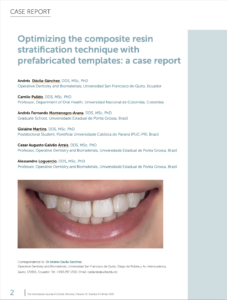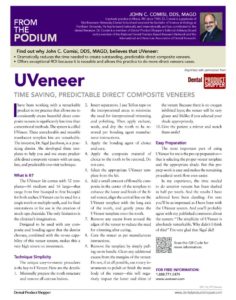Description
Product Details
The unique, innovative Uveneer direct composite template system creates beautiful direct composite veneers with predictable shape and symmetry. It mimics natural dentition and is designed to create high-quality, natural-looking anterior restorations in one visit. Uveneer templates use innovative technologies that help achieve a refined, anatomically correct, high-gloss restoration in a fraction of the time of what it would take if done freehand. Results are both reproducible and predictable.
- Allows for predictable, high-quality, natural-looking composite restorations
- Prevents the oxygen inhibition layer during curing process resulting in a hard, glossy surface
- Allows light to pass through the template to the composite for effective curing
- Works with any preferred composite
- Releases easily from cured composite resin
- Requires minimal adjusting or polishing—saving time
- Can be used on individual or multiple teeth
- Templates are autoclavable and reusable, making it cost effective for both patients and dentists
- Can enhance practice efficiency
- Each template is numbered to correspond with the tooth number, tooth size, and upper and lower arch
Indications for Use
Use Uveneer template system for direct composite veneer applications, cosmetic mock-ups and shade selection, temporaries during porcelain veneer creation, and all Class 3, 4, and 5 cases.
Before & After
For many more cases from Dentists around the world, please join our Facebook page, Uveneer by Ultradent.
Case 1. Done by Dr Ian Shuman

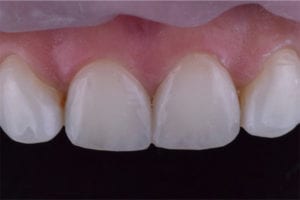
Case 2. Done by Dr Victor Acosta


Case 3. Done by Dr Robert Lowe


Case 4. Done by Dr Sigal Jacobson


Case 5. Done by Dr Sigal Jacobson


Case 6. Done by Dr Sigal Jacobson


Case 7. Done by Dr Sigal Jacobson
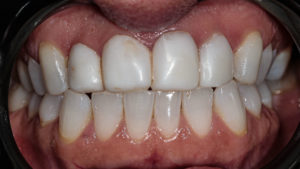

Case 8. Done by Dr Sigal Jacobson

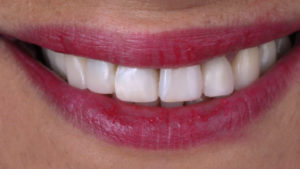
Videos
#1 – Uveneer Animation Studio: How It Works
#2 – Demo with a Patient (Short Version)
#3 – Peg Lateral And Diastma Closure
#4 – Uveneer Temporization Technique
#5 – A Beautiful Case By Dr Victor Acosta
#6 – Case by Dr. Newton Phal
#7 – Dr Dan Fischer and Dr Jacobson talking about Uveneer
#8 – Uveneer on a Patient
#9 – Uveneer with Patient (Spanish version)
#10 – Uveneer Kit Contents
#11 – Prominent Dentists Discussing Uveneer
#12 -Voco-UVeneer Chairside Bonded Provisional
#13 – Dental Art Innovations
#14 – Uveneer Model Demonstration Video
#15 Dr Newton Fahl speaks about Uveneer
Technical Details
The Only Direct Composite Template System
The Uveneer template system is the only template system designed to create beautiful direct composite veneers in one visit. With Uveneer templates, clinicians can create veneers with predictable shape and symmetry every time, for every patient.
Constructed of Translucent Material
Each translucent template allows light to transfer from the curing light through to the composite. Uveneer templates prevent the creation of a composite oxygen inhibited layer during the curing process, thus leaving a finished glossy and contoured surface.
Will Not Stick to Composite
Uveneer templates are made from medical grade translucent plastic with a nonstick coating and are both reusable and autoclavable.
Kit Includes Templates For Maxillary Anterior Teeth, Canine to Canine
The Uveneer Extra template system kit features 24 templates in total, including four sizes: Extra Large, Large, Medium, and Square. Each size consists of 6 maxillary templates from canine to canine. Each Uveneer Extra template is numbered to correspond with tooth number and template size to assist in correct placement.
Procedures
Uveneer Direct Composite Template System Step by Step
– See Instructions for Use for complete instructions, warnings, and precautions.
Step 1:

Choose Mosaic™ universal composite or preferred composite shade(s). Select the template that corresponds with the tooth being restored. See handle of template for corresponding tooth number, size, and arch.
Step 2:

Remove all caries if needed and minimally prepare the tooth.
Step 3:
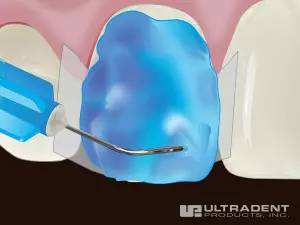
Place interproximal separating matrices and apply Ultra-Etch™ etchant, Peak™ SE Primer, or preferred etch.
Step 4:

Rinse etch according to manufacturer’s instructions. Do not rinse if using Peak SE Primer.
Step 5:

Apply Peak™ Universal Bond adhesive or preferred adhesive to tooth surface.
Step 6:

Light cure with VALO™ curing light 1 x 10 seconds on Standard Power. If using other curing light, cure according to manufacturer instructions.
Step 7:

Apply Mosaic universal composite or preferred composite directly onto tooth.
Step 8:

Do not light cure composite.
Step 9:

Select chosen Uveneer template. Template should ideally cover the entire facial surface of the tooth. If not, additional composite may be used at the periphery to compensate.
Step 10:

Align centerline of template parallel to the midline of the face and perpendicular to the incisal plane. Using thumb, press the concave side of the selected template onto the tooth. Press firmly to remove any trapped air.
Step 11:

Remove any excess composite from the periphery.
Step 12:

Using VALO curing light, cure composite through template. For every 2mm layer, cure 1–2 x 10 seconds on Standard Power, 1–2 x 4 seconds on High Power, or 1–2 x 3 seconds on Xtra Power. If using other curing light, cure according to manufacturer instructions.
Step 13:

Remove the Uveneer template by gently lifting the handle. Using VALO curing light do final cure directly onto composite. To ensure composite is cured thoroughly, for every 2mm layer, cure 3 x 10 seconds on Standard Power, 3 x 4 seconds on High Power, or 3 x 3 seconds on Xtra Power. If using other curing light, cure according to manufacturer instructions.
Step 14:

Avoiding the glossy facial surface, trim excess composite from periphery with a fine flameshaped bur in Jiffy™ Composite Finishing Bur Kit. Use Jiffy™ Composite Polishers, Brushes, Diamond Strips, or Proximal Saws for minimal finishing and adjusting if desired.
Step 15:

Immediately after use, thoroughly wipe template with alcohol pad, dry, bag, and autoclave according to Uveneer template IFU. Do not leave any composite residue on the template in order to maintain translucency and shine.
Step 16:

Testimonials
For many more tips, testimonials, and cases, join our Facebook group: Uveneer byUltradent.
Here’s what dentists around the world are saying about Uveneer™.

“It only took one case for me to realize that Uveneer deserved a place on my dental “tool belt.” Whether restoring a single incisor or taking on a set of direct composite veneers, Uveneer will provide a rapid and attractive solution to the anterior restorative task at hand. Consider it a “must have!””
Dr. Martin B. Goldstein DMD, FAGD
Lectures nationwide on cosmetic dentistry Contributor to Dental Products Report & Dentistry Today

“Uveneer is one of those simply brilliant ideas that all of us wish we had thought of first. A terrific tool to quickly and easily create beautiful anterior restorations.”
Gary M. Radz, DDS, FACE, Colorado USA
Board member of Academy of Comprehensive Esthetics AACD – Professional Education Committee – Co-Chair
Associate Clinical Professor at the University of Colorado

“A unique product that greatly simplifies cosmetic dentistry. A great interim or permanent solution for esthetic challenges.”
Peter Auster, DMD, New York USA
President, Empire State Academy of Cosmetic DentistryMember, Board of Directors, American Academy of Cosmetic Dentistry

“The simplicity of Uveneer is absolutely remarkable. Why didn’t I think of this? So glad you did!”
Dr. John C. Comisi, DDS, MAGD
Dr. Comisi lectures on various dental topics and procedures, has presented courses nationally and internationally and has been published in many dental journals and health car magazines.

“It is well established that the use of composite resin for aesthetic enhancements to the smile is a clinically relevant technique. The patient can receive a restoration with less tooth destruction and at a lower cost compared with porcelain veneers.Here finally a user friendly, simple low cost way for the average dentist to do a veneer in composite resin, or a full set, quickly, simply and with predictable results.However, free-hand direct composite bonding is at all times a difficult technique. Part of the difficulties lie with the process of designing, adjusting, shaping and polishing the restoration in order to achieve an aesthetically pleasing result.The Uveneer is a great innovation that solves many problems associated with delivering direct composite veneers.The operator can produce composite veneers that require less dexterity requirements and adjustments are simple, so time is saved in giving the patient an incredible smile.I think the Uveneer is an incredible invention and offers the dentist another feather in his/her bow.”
Dr. Terry Wong, BDSc, Melbourne, Australia
Valuator of Dental materials for major dental companies and presently lectures on the subject of aesthetic dentistry at Melbourne University.Conducts hands-on programs on composite veneers.

“I have always free handed my cosmetic mock-ups on my patients, usually during hygiene appointments. With Uveneer, I have greatly reduced the time to mock-up and then reproduce the final restoration. Uveneer makes it fast, predictable and affordable for patients. In a single day I was able to do 11 mock-up veneers that were not part of the original schedule, resulting in several new cases being accepted. I wouldn’t want to work without them now.”
Chad Wagener DDS, Iowa USA
Instructor at the University of Iowa

“I purchases Uveneer at Midwinter Chicago Meeting. I can’t stop doing the veneers since the purchase!!!Thank you for the great invention.”
Charles J Callea DDS, Illinois USA

“A simple masterful piece of dental kit that allows the dentist nor just the ability to do a veneer, but a temp bridge, a cover for an implant repair a broken tooth, disguise a stain, and so much more.Here finally a user friendly, simple low cost way from the average dentist to do a veneer in composite resin, or a full set, quickly, simply, and with predictable results.I am absolutely convinced that Uveneer will totally revolutionize dentistry now and for years to come, an idea that was meant to be.”
Dr. Harry Marget, BDS, LDS, Melbourne Australia
President, Empire State Academy of Cosmetic Dentistry.Member, Board of Directors, American Academy of Cosmetic Dentistry

“Uveneer is an excellent aid in restoring anterior teeth and provide an enormous benefit in terms of shaping, angulation and proportioning of the anterior teeth when undertaking labial veneer restorations. I have found them useful not only for full labial veneers, but also for the repair of tooth wear and erosion cases where incisal length has been lost. They are also useful for making temporary veneers and indirect veneers which are then cemented with resin.”
Professor Ian Meyers BDSc, FICD, FADI, FRACDS, FPFA
Honorary Professor QLD UniversityDirector ADA Queensland CPD
Articles
FAQ
How do Uveneer templates work?
What curing light works best with Uveneer templates?
Any curing light can be used with Uveneer templates. VALO™ curing light is the optimal choice because of its quality and durability.
What type of composite should I use?
Can Uveneer templates increase practice profitability?
Yes! Dentists who use Uveneer templates report that they are performing many more composite veneer procedures than before because they find the process so quick and easy—and affordable for their patients, which has led to higher case acceptance.
Are Uveneer templates reusable? Autoclavable?
What are the main advantages of using Uveneer templates?
When should I use Uveneer direct composite template system?
Uveneer templates can be used for any application where the facial side of the tooth needs to be rebuilt.
- Applications include:
- Direct composite veneers
- Mock-ups
- Temporaries while porcelain veneers are being made in the lab
- Broken teeth and Class V, IV restorations
- As a stent for gum contouring
What prompted this innovation?
Will the shine from Uveneer templates last?
Are Uveneer templates cost effective?
How long do the Uveneer templates last?
Is there a learning curve when first using Uveneer templates?
How does this system compare with prefabricated composite veneers?
How do I utilize Uveneer templates when performing a Class IV restoration?
Before beginning any restoration, we recommend cleaning off any decay, slightly preparing the facial side of the tooth so that the template has a passive fit, placing the separating matrix, etching, bonding, and then covering the facial side of the tooth with composite. This way you will prevent the patchy look that can come from minor staining in the future.For a Class IV restoration, or to extend the length of the tooth, simply apply the composite directly to the tooth, filling in the missing areas free-hand, and then press the Uveneer template onto the composite from the facial side and apply pressure from the palatal side with your finger. We recommend using Mosaic™ universal composite in these cases to create the perfect glossy finish and minimize color changes.
How can you use Uveneer templates to restore a peg lateral on the lingual side?
- Place separating matrix.
- Etch, bond, and cure.
- Apply the matching shade composite on the tooth in the same manner as if you were to finish the case free-hand. Ensure you close the gaps and apply composite on the facial side as well.
- Press the Uveneer template that matches the size and tooth number onto the composite on the tooth and apply pressure from the palatal side on the composite and press it flat with the palatal side of the tooth.
- Remove excess composite with a probe. Spot curing for 1–2 seconds will help with the cleaning process.
- Finish curing.
- Remove any excess material from the periphery with a fine bur and polishing discs. Do not touch the facial glossy surface during the finishing process.
How do you avoid ledging in the emergent zone?
Correctly finishing a composite veneer is an important step for the health of the surrounding tissue and can help prevent ledging.Before pressing the Uveneer template over the composite, make sure to not overload the tooth with composite resin. If you apply more than needed you will end up with too much excess to clean. Apply enough resin (or less, as a second layer can be added later) to finish the case without the Uveneer template. Next to the gingival areas apply minimal to no composite as pressing the Uveneer template will spread the composite to those areas. Just before curing, use a fine probe and remove the majority of the excess while applying finger pressure directly on the template. A quick spot cure can also help with removing resin excess. After the final curing, use an extra fine diamond flame shape bur for the final flash removal. For finishing the interproximal areas, use a seesaw and polishing diamond strips.
Can Uveneer templates be used with children?
I completed two restorations—one with a Uveneer template and one free-hand. Both were prepped the same. How come the Uveneer template tooth was whiter than the free-hand tooth?
Difference in color between adjacent teeth can be a result of a few different things. Sometimes, a difference in thickness of composite between the two teeth can change the final color of the restoration. The thicker the layer of composite, the higher the shade value of the final result. It could be that more composite was used with the free-hand restoration than with the Uveneer template. Because of the concave shape of the template, the composite material will spread more which will create more natural value. In order to ensure the same final shade and value, use same thickness of composite and the same technique on both teeth.There may have also been a difference in the original color between the two teeth. To avoid differences in the final shade, always complete a direct mock-up on the tooth with a Uveneer template so you can better determine the final outcome before etching and bonding.
What should I do if the veneer changes color after the restoration was completed?
If a patient does return with stained veneers, use a bur to remove the top layer of stained composite. Etch, rinse, bond, cure, and add a new layer of composite with the correct Uveneer template and cure.Smoking, red wine, coffee, tea, and certain foods can stain composites. In addition, flowable composites have a low amount of filler and can stain or change color, particularly if a layer of flowable composite is used as the top surface layer. If a flowable is used with the Uveneer template system as the top surface layer, it should be a flowable with a heavy fill and more filler particles.
Also keep in mind that composite can be under-cured, but not over-cured. We recommend using a strong curing light like the VALO™ curing light to ensure a complete cure.
If a patient has a wider or longer tooth than the template, can I still use the Uveneer template system?
When we created the Uveneer templates, we looked at various studies about smile design, rules, and proportions, so most patients will fit into the templates in your kit. However, some patients grind their teeth or will have gum recession. In these cases, you can adjust the veneer to the desired length with a bur or disc. If the patient has gum recession, you can also add some composite next to the gums as if you were doing a Class V restoration.If the patient has large or wider teeth, you can complete the restoration by pressing the template and blending the excess composite to periphery. Some small finishing adjustments may be required.
When should I use a flowable composite?
Brochures
Order Online
Ultradent is the exclusive global distributor of Uveneer
For USA orders click here to order or call 1.888.230.1420.
For international orders click here to find a distributor in your country or email info@uveneer.com















